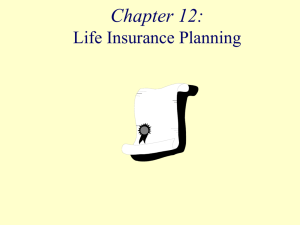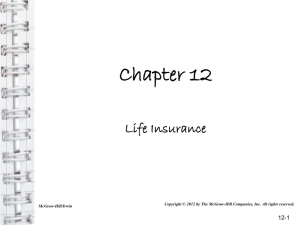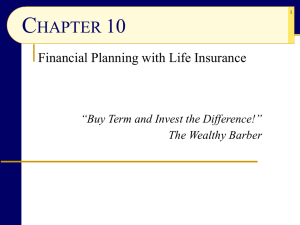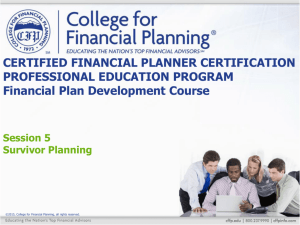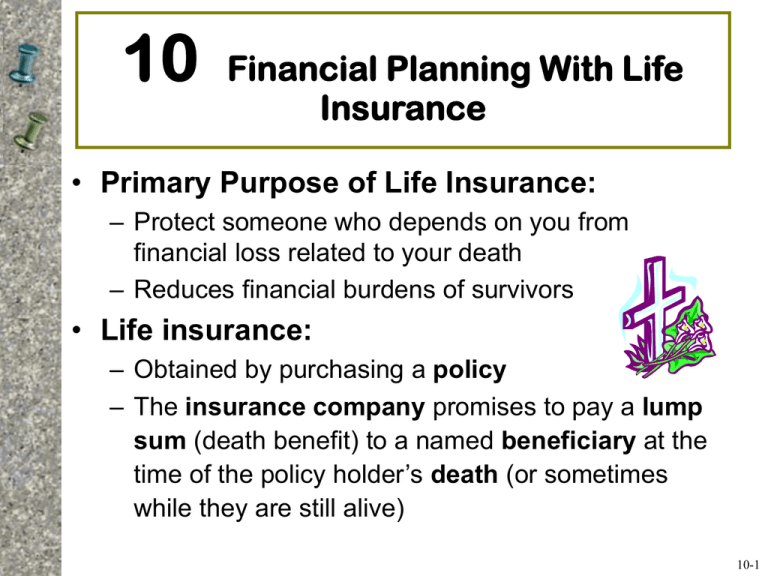
10
Financial Planning With Life
Insurance
• Primary Purpose of Life Insurance:
– Protect someone who depends on you from
financial loss related to your death
– Reduces financial burdens of survivors
• Life insurance:
– Obtained by purchasing a policy
– The insurance company promises to pay a lump
sum (death benefit) to a named beneficiary at the
time of the policy holder’s death (or sometimes
while they are still alive)
10-1
Objective 1
Define Life Insurance and Determine
Your Life Insurance Needs
Other reasons to buy life insurance:
– Pay off a mortgage or debts
– Lump-sum endowments for children
– Provide an education or income for children
– Make charitable donations
– Provide retirement income
– Accumulate savings
– Establish a regular income for survivors
– Set up an estate plan (e.g., fund trusts with life insurance)
– Pay estate and gift taxes (e.g., business owners)
10-2
The Principle of Life Insurance
• Mortality Tables-provide odds on your
dying, based on your age and sex.
• Premium is based on life expectancy
and projections for payouts for persons
who die (called actuarial tables)
– Older people pay more because they will die
sooner
• Face Amount- the dollar value of
protection listed in the policy and
amount used to calculate the premium
(e.g., $100,000)
• Group Term Insurance- issued to
people as members of a group rather
than as individuals
10-3
Do You Need Life Insurance?
• Do you have people you need to protect financially? Will
your death cause them financial hardship?
• Are you single and have a lot of debt?
• Do you have parents, relatives, or a charity that you want
to support?
Avoid being persuaded to buy unnecessary life insurance!
10-4
Estimating Your Life Insurance
Requirements
• The Easy Method
– 70% of your salary for seven years while your family adjusts
– Assumes typical family
• The DINK Method
– Dual income, no kids
– Assumes spouse earnings will continue
– Cover funeral + ½ debts
• The “Nonworking” Spouse Method
– # years until the youngest child reaches 18 X $10,000
• The “Family Need” Method
– More thorough than the first three methods
– Considers employer provided insurance, Social Security benefits,
income and assets
10-5
Objective 2
Distinguish Between the Types of Life
Insurance Companies and Analyze
Various Types of Life Insurance Policies
These Companies Issue
2 Types of Life Insurance Companies
Type of Company
Owned by
Stock life Insurance
Shareholders
Mutual life insurance
Policyholders
10-6
Stock Life Insurance Companies
•
•
•
•
Owned by the shareholders
95% are of this type
Sell non-participating (non-par) policies
If you want to pay the same premium
each year choose a non-participating
policy with guaranteed premiums
• Consider the financial stability of the
insurance company
10-7
Mutual Life Insurance Companies
• Owned by the policyholders
• 5% of policies are from this type
of company
• Participating policy premiums are higher
than non-participating policies
– Part of the participating premium is refunded
to the policyholders annually in the form of a
policy dividend
10-8
Term Life Insurance
Term Life
– Protection for a specified period of time
– At the end of term (or if you stop paying premiums),
coverage stops
• Many types:
– Renewable Term- can renew; higher premium charged
– Multiyear Level Term- same premium for set period
– Conversion Term- allows change to permanent policy
– Decreasing Term- face value decreases over time
– Return-of-Premium Term- can get premium back
10-9
Whole Life Insurance
Straight-Life or Whole-Life Insurance
•
•
•
•
– Pay the premium as long as you live
– Amount of premium depends on age when you start
the policy
– Provides death benefits
– Accumulates a cash value you can borrow against or
draw out at retirement
– Look carefully at the rate of return your money earns
Types:
Limited Payment Policy
– You pay premiums for a stipulated period
– Policy then “paid up” and you remain insured for life
Variable Life Policy- Fixed premiums; investment accounts
Adjustable Life Policy- Can change coverage with needs
Universal Life- Can change premium, time period, benefit
10-10
Comparison of Premium Dollars for
Life Insurance
Other Types of Life
Insurance Policies
• Group life insurance
– Term insurance
– Often provided by an employer
– No physical is required
• Credit life insurance
– Debt paid off if you die
• Mortgage, car, furniture
– Also protects lenders
– Expensive protection (usually overpriced)
• Endowment Life Insurance- pays
policyholder a lump sum if still living at end of the
endowment period
10-12
Key Provisions in a Life
Insurance Policy
• Naming your beneficiary and contingent beneficiaries (those
who will receive benefits upon the insured’s death)
• Incontestability clause after the policy has been in force for
a specified period, the company can’t dispute its validity for any
reason (usually 2 years)
• Length of grace period for late payments
• Reinstatement of a lapsed policy if it has not been turned in for
cash (must qualify again and pay overdue premiums)
• Non-forfeiture clause allows you to keep accrued benefits in a
whole life policy if you drop the policy
• Misstatement of age provision (benefits paid on real age)
• Policy loan provision to borrow against cash value
• Suicide clause during first two years (only get back premiums)
• Policy rider modifies the coverage by adding or excluding
conditions or altering benefits
10-13
Key Provisions in a Life
Insurance Policy
Life Insurance Policy Riders
• Waiver of premium disability benefit
• Accidental death benefit – “double indemnity”
• Guaranteed insurability option (can buy additional insurance at
specified intervals without a medical exam)
• Cost of living protection (helps maintain purchasing power)
• Accelerated benefits, also called living benefits (make
payments to those who are terminally ill before they die)
• Second-to-die option, also called survivorship life (insures two
lives, typically a married couple); benefit paid upon death of
second spouse
10-14
Choosing Settlement Options
Settlement Options = choices of how the
insurance money is paid out
– Lump-Sum Payment = most common method
– Limited Installment Plan
• In equal installments for a specific number of years
after your death (10-year certain)
– Life Income Option
• Payments to the beneficiary for life
– Proceeds Left with the Company
• Pays interest to the beneficiary
10-15
Buying Life Insurance
Consider:
– Present and future sources of income
– Other savings and income protection
– Group life insurance
– Pension benefits
– Social Security benefits
– Financial strength of
the
insurance company
10-16
Buying Life Insurance
Determine from whom to buy your policy
– Examine both private and public sources
– Research the company’s rating by major
rating companies:
• A. M. Best
• Standard and Poor’s
• Duff & Phelps
• Moody’s
• Weiss Research
– Talk to friends or colleagues
– Online premium quote services
10-17
Choosing an Insurance Agent
• Ask friends, parents, and neighbors
for recommendations.
• Does the agent belong to
professional groups or is a
Chartered Life Underwriter (CLU)?
• Is the agent willing to take the time
to answer questions and find a
policy that is right for you?
• Does the agent ask about your
financial plan?
• Do you feel pressured?
• Is the agent available when
needed?
10-18
Buying Life Insurance
• Compare policy costs based on:
– Company’s cost of doing business
– Return on company’s investments
– Mortality rate among policyholders
– Policy features
– Competition from other firms
• Interest-adjusted index
– Used to compare policy costs
– Lower index = lower cost policy
– See sites such as www.quotesmith.com
10-19
Obtaining and Examining a Policy
• First step = apply
• Second step = provide medical history
– Usually no physical for a group policy
• Read every word of the contract
• 10-day “free-look” period to change
your mind
• Give your beneficiaries
and lawyer a photocopy
10-20
Should You Switch Policies?
• Switch if benefits exceed
costs of getting another
physical and paying policy
set-up costs
• The older you are, the higher
the premium
• Are you still insurable?
• Can you get all the provisions
you want?
• Don’t cancel old policy until
new policy is in hand
10-21
Objective 4
Recognize How Annuities Provide
Financial Security
Financial Planning with Annuities
• An annuity = a financial contract written by an
insurance company, providing a regular income
• Can supplement retirement income and shelter
income from taxes (tax-deferred)
• Those who expect to live longer than average
benefit most from annuities
• Fully fund IRAs and 401(k)s/403(b)s BEFORE
considering an annuity (lower costs and tax advantages)
10-22
Why Buy Annuities?
• Provides retirement income for life
• Compounded interest grows tax-free (until money withdrawn)
• No maximum annual contribution (like IRAs)
• Beneficiary guaranteed no less than amount paid in
• Immediate annuity or deferred annuity
Two Types
• Fixed Annuity
– Annuitant receives fixed amount for life
• Variable Annuity
– Amount received depends on investment performance
10-23
Wrap Up
• Chapter Quiz
• Case Study Project Discussion
– Form groups
– Select cases
• Homework: Concept Checks 10-1, 10-2
(True/False Questions)



